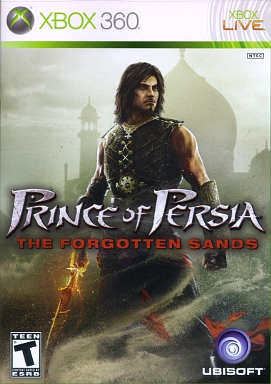
Prince of Persia: The Forgotten Sands
A gorgeous action puzzle game that regrettably chooses cinematics over playability
I've been playing video games since Pong came out over 30 years ago.
I still love the old coin-op games: Donkey Kong, Centipede, Galaga, Defender.
Most of those stand-up game consoles have taken a beating over the years.
When I'm lucky enough to find one tucked away in the back of an arcade or a tiny
pizza place, something about the controls is generally awry.
Maybe the ball on the Centipede machine doesn't roll properly in a certain direction.
Maybe the Donkey Kong machine's jump button sticks.
Whatever the problem, my drive down memory lane gets a flat tire and I have to give up quickly.
The Prince of Persia designers could learn a thing or two from those old game machines.
It doesn't matter how fun or clever the game is in the abstract—if the controls don't work properly,
the game experience falls apart. That's what happened with Prince of Persia: The Forgotten Sands.
PP:TFS starts off magnificently. Boot-up and load times are the shortest I've seen on an XBox 360 game.
The graphics are rendered at a Final Fantasy level of detail, individual strands of hair and all.
The Prince's movements contain many lifelike touches: teetering on the edge of a precipice,
or struggling for purchase after grabbing a beam one-handed.
Combat is simple but requires shrewd tactical play. Tutorial mode is well-paced and largely unobtrusive.
The core of PP:TFS is the "action puzzle".
The player must figure out to get from the entry of a stage (usually a room or
corridor) to the exit via clever planning and physical feats.
The Prince jumps, runs along walls, hangs from ledges, clings onto columns, swings
from horizontal poles, and climbs on protruding bricks to reach his destination.
Sometimes the stage requires manipulation of levers to open up paths.
Sometimes there are traps: floor spikes, sawblades, spiked logs, and so forth.
The complexity of the puzzles increases at a satisfying pace,
allowing the player to become proficient at one technique before going on to the next or combining techniques together in new ways.
Many of these puzzles take place in large, beautifully rendered palace halls.
Since the spaces are so large, the camera moves around as the Prince progresses through the puzzle's obstacles.
This is where the game falls apart. The game's designers apparently chose their
camera angles to show the action as cinematically as possible.
The Prince's position relative to the camera constantly changes: behind, above, to the sides, all to varying degrees.
The player can swing the camera view around in exploration areas, but movement
is very limited during puzzle-solving and the camera always snaps back to default position.
That would all be fine—enjoyable, in fact— if the control scheme stayed constant.
The problem is, sometimes the controls seem like they're relative to the Prince's
position and sometimes they're relative to the camera.
There's no way to tell which is in effect at any given time,
until the player does the "wrong" thing and has to start over.
At lower levels, this isn't much more than an annoyance.
After eight or so hours of play, it becomes a game-breaker.
Puzzles increasingly depend on tricky combos: wall run, jump backwards off the wall to a
flagpole, jump to another flagpole, jump to another wall, wall run upward,
jump backward off that wall, and finally arrive on solid ground, all while on a timer.
In this particular example, movement is all directional.
The camera angle changes three times, requiring three adjustments to the control scheme.
The first scheme is relative to the camera; the second is relative to the Prince;
and the third remains a mystery, because I mysteriously got it on the sixth try and I'm still not sure how.
I gave up on the game about 45 minutes later,
after my eighth time failing a puzzle involving bricks, wall runs, and wall-to-wall jumping.
The camera angle made it nearly impossible to see the destination bricks
(not to mention parallax obscuring the proper jumping-off points)
so the Prince fell to his death over and over again.
I couldn't move the camera at all for a better view.
So that was the end, and here we are.
I've played action puzzle games before.
I enjoy them. I'm reasonably talented at playing them.
I've never seen one as pretty or as frustrating as Prince of Persia: The Gathering Storm.
Final verdict from this reviewer: thumbs down.
[ PS: There is a movie out - Prince of Persia: The Sands of Time Reviewed by: Finn Kisch - May/10
Rating: T - Teen
Generally it's done the other way - movie to game. But it was fun just to
relax and let the actors do all the jumping
(parkour), and fighting.
If you have played the game you have the added kinesthetic experience of
reliving the Prince's moves. Of course there is more
story, supporting characters come to life, romance, actually seeing the sands of time.
Oddments include Alfred Molina as the ostrich-loving sheik.
All in all, a fun time had by all. BTW - How many in
the audience realized that Persia is today's Iran? - Gen ]